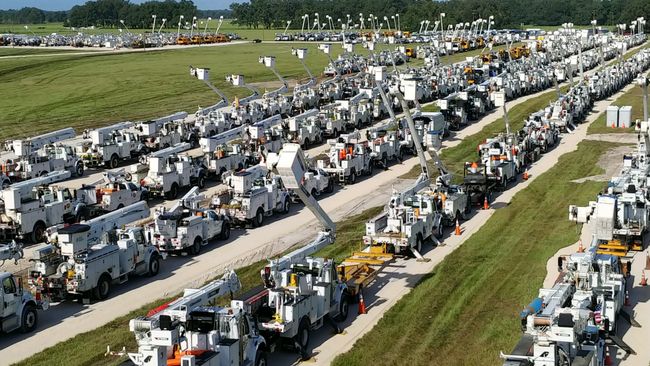Gulf Coast electric and power companies continue to prepare for Hurricane Dorian

Power companies in the potential path of Hurricane Dorian activated their emergency response plans and are positioning workers and equipment in the areas most likely to be hit by the storm.
Dorian is a Category 2 hurricane that has stalled out over the Bahamas as of Tuesday. The path is uncertain at this point but could hit Florida or move up the eastern seaboard
Utility crews from at least 36 states, the District of Columbia, and Canada are ready to help if needed, according to the Electricity Subsector Coordinating Council (ESCC), which helps coordinate efforts between the federal government (the Department of Energy, Homeland Security, and Federal Emergency Management Agency) and the electric power industry to prepare for such emergencies.
“One of our greatest strengths as an industry is our ability to remain nimble and adapt to Mother Nature’s unpredictable behavior,” Edison Electric Institute (EEI) President Tom Kuhn said. “Strong industry-government coordination and cross-sector collaboration are critical, and we appreciate the ongoing leadership from DOE, DHS, and FEMA in helping to coordinate the industry response with federal, state, and local officials.”
People in Florida, Georgia, South Carolina, and North Carolina should be prepared for the possibility of power outages, ESCC officials say. If ordered to evacuate, they should do so immediately as the risks of storm surges, damaging winds, and severe flooding are heightened due to the slow-moving nature of the storm.
“The electric power industry has coordinated recovery and mutual assistance plans ahead of Hurricane Dorian’s arrival, and we are prepared to respond to extended outages around the clock as soon as it is safe to do so,” National Rural Electric Cooperative Association CEO Jim Matheson said. “As the storm track continues to shift, we are praying for the best and preparing for the worst.”
Florida Power & Light Company has pre-positioned equipment in preparation for the storm. It has deployed the largest pre-storm restoration workforce in company history with 17,000 workers ready to respond to this storm, which was downgraded to a Category 2 Tuesday morning.
“Dorian remains a very dangerous hurricane with an unpredictable track and intensity as it inches toward Florida. Customers should stay vigilant as significant parts of our service territory remain within the cone of uncertainty,” Eric Silagy, president and CEO of FPL, said. “This is a challenging and very slow-moving storm that will impact our service area with tropical storm-force winds for an extended duration. Rest assured, as long as it is safe to do so, our crews will be out restoring power as the first bands of severe weather move through, and we’ll work continuously after the storm clears until all customers have power again.”
The company has pre-staged sleeper trailers with more than 4,000 beds; almost 60 drone teams; thousands of pre-positioned transformers and poles; and 75 fuel trucks able to supply more than 3.5 million gallons of fuel. FPL has set up more than a dozen staging sites so that workers will be in place to restore power safely and as quickly as possible.
“As soon as it is safe to do so after the storm passes, FPL personnel will be out in the field actively working to determine the extent of damage from this powerful hurricane,” Silagy added. “They must do this before we can provide an estimate of how long it will take to restore service.”
Duke Energy has put nearly 9,000 transmission and distribution personnel in place to support power restoration, which is almost three times the average number of crews in the state. Duke crews are being staged at The Villages, Davenport, and Clearwater to be ready to respond to outages as soon as it’s safe to do so. Further, the utility has mutual assistance agreements with other utilities through the Southeastern Electric Exchange. Duke urges customers in the projected path to pay attention to information and advice from state and local emergency management officials.
“Ensuring the safety of customers, communities, and crews is the electric power industry’s highest priority,” Sue Kelly, president and CEO of the American Public Power Association, said.
